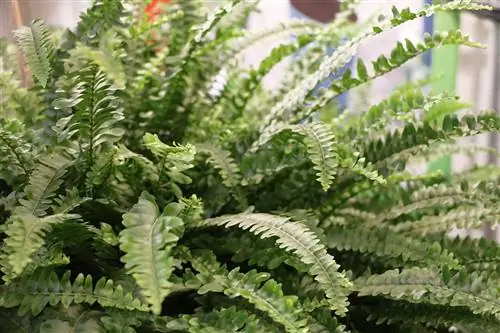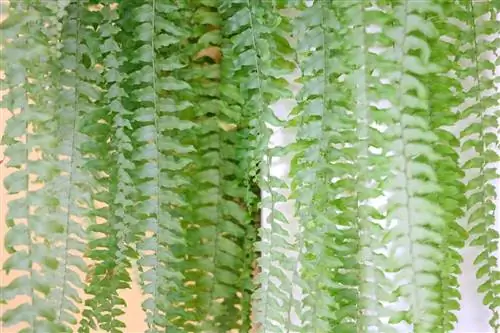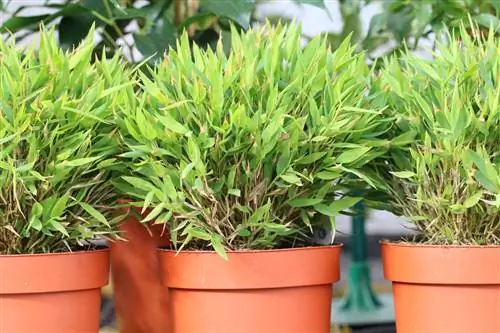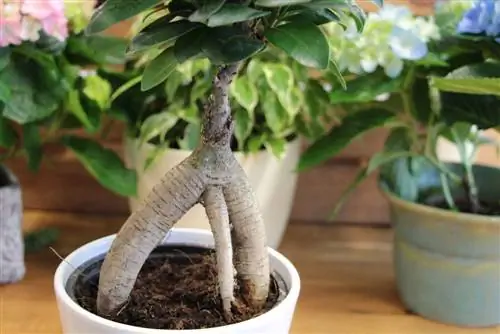- Author admin [email protected].
- Public 2023-12-17 03:39.
- Last modified 2025-01-24 12:45.
As a houseplant, fern is one of the easy-care plants. The low cost and decorative value explains the popularity of these prehistoric plants. Room fern care is explained to you in detail in this guide.
Profile
- Plant group: ferns
- includes numerous species
- Classes: True ferns (Polypodiopsida), Psilotopsida, Equisetopsida, Marattiopsida)
- all species are monophyletic (single-stemmed)
- Distribution: worldwide
- Growth habit: upright, bushy, overhanging, deciduous, evergreen, rarely as a tree or palm
- Growth height: 10 cm to 3,000 cm
- forms spore capsules on the underside of the leaves
- Leaves: fronds in species-dependent sizes, various shades of green, pinnate
- entire group poisonous
Species
Of the over 12,000 fern species in the world, a small number are ideal for long-term indoor cultivation. Indoor ferns do not differ from their relatives in any way; they can only be kept in the house without any problems because of their growth characteristics and needs. The following list gives you an overview of suitable species that you can keep as a room fern:
- Maidenhair fern (Adiantum raddianum)
- Staghorn fern (Platycerium bifurcatum)
- Goldspotted Fern (Phlebodium aureum)
- Hare's foot fern, hare's foot fern (Davallia bullata)
- Japanese sago palm fern (Cycas revoluta)
- Nest fern (Asplenium nidus)
- Pelle fern (Pellaea rotundifolia)
- Struthiopteris spicant
- Sword Fern (Nephrolepis ex altata)
Location

One of the most important points when caring for an indoor fern is the location. Ferns do not need to be cared for extensively if you give them a suitable place in the home. When choosing a location, pay attention to the following characteristics:
- Light requirements: bright, shady to partially shaded
- avoid direct sun
- avoid shady corners
- Minimum temperature: 12°C
- Avoid drafts
Tip:
Due to the higher humidity, bathrooms are particularly suitable for plants. The bathroom should have a window, otherwise it will be too dark.
Substrate
In addition to the selected space in your living space, you must choose a suitable substrate. Basically, you can use the same substrate for all indoor ferns, which gives you plenty of freedom in choosing the species. The following properties are important:
- high-quality potting soil
- permeable
- humos
- slightly moist
- calcareous
Note:
Some types of ferns such as the hare's-foot fern do not require a substrate because they are an epiphyte. For this you only need a large, porous stone that the fern can cling to.
Repotting
In order to maintain the growth and vitality of an indoor fern, the plant must be repotted at regular intervals. Over time, the container becomes too small for them and the soil becomes compacted or too lean. To avoid this problem, you need to repot at the right time. Repotting takes place directly after winter in the period from February to March. You should not repot later as the ferns will sprout again. The frequency is just as important, because depending on the age and growth habit of the ferns, you have to observe a different rhythm:
- young specimens: every 1 to 2 years
- older specimens: every 4 years
- Ferns in tree or palm shape: 5 to 6 years
- Roots grow from pot drainage holes
The houseplant thrives best in pots that are not too deep. The shallow rooter doesn't need much space, but it roots through the substrate over time.

Once it's time to repot, you can use the following instructions as a guide:
- slightly choose a larger pot
- should have drainage holes
- Removing the plant from the old pot
- Removing soil from roots
- remove dead, dried or rotten roots
- also remove dried or brownish fronds
- Create a drainage layer on the bottom of the pot
- Drainage material: expanded clay, clay shards, gravel
- fill a third of the pot with substrate
- Just inserting plant
- fill up
- press carefully
- water well
Note:
You can easily cultivate many species in a hanging basket. This method is particularly suitable if you don't have enough space for proper tubs.
Pouring
An essential point in caring for room ferns is providing them with plenty of water. The plants rely on large amounts of water, but should never be exposed to waterlogging. Standing moisture leads to root rot, which can be fatal for the houseplant. For this reason, you should only water as needed. You can do this by regularly checking the top layer of soil for dryness. If it is completely dry, water. Make sure that you only use low-lime water, for example filter water or rainwater.
Tip:
A fresh boost for the room fern is an occasional spray mist. Fill a spray bottle with suitable water and spray the plant generously.
Fertilize
House ferns do not require any additional nutrients if they have been repotted at the right time and a suitable substrate is used. If you still notice deficiency symptoms such as drooping or pale fronds, you can add additional fertilizer. This is possible from spring to autumn because the ferns stop sprouting over the winter and therefore do not need any nutrients. To fertilize, use a classic flower or pot plant fertilizer administered as follows:
- every 2 weeks
- administer via irrigation water
- Use half the recommended dosage
- alternatively, fertilize in the same way with milk
Cutting
Ferns don't really need to be cut back unless they are deciduous species. In this case, pruning before winter is necessary. This can be recognized by the color of the leaves, because the closer winter comes, the more the fronds turn brown. Brown fronds are always a sign of dry plant parts that the fern no longer needs and can safely be cut off. If you can no longer prune the houseplant in the fall, move the date to spring. You just have to be careful not to damage new fronds. The cut works like this:
- Put on gloves
- Ferns are poisonous
- use disinfected, sharp scissors
- cut back deciduous species completely
- all fronds down to the ground
- thinning out evergreen species
- only remove brown fronds
Wintering
Winter is a big problem for houseplants as they cannot tolerate temperatures below 12°C. Fortunately, the annual location is also suitable for overwintering. The only problem can be persistent dryness if the heating is on over the winter. Dry heating air ensures that your indoor fern loses moisture more quickly. To prevent this problem, you need to check the substrate for moisture more often. It is also advisable to spray the fern with water more often than usual so that the fronds do not dry out. Sufficient moisture protects against typical drought pests such as spider mites.

Propagate
Since ferns in the wild develop via their spores, you have to take action yourself if you want more specimens. Reproduction via spores is theoretically possible, but can take one to two years. For this reason, indoor ferns are best propagated by dividing the root ball. Since indoor ferns are extremely robust, this method poses no danger to them and the entire process takes place without any major problems. Alternatively, you could use cuttings, but not every room fern produces these. The division is ideally carried out during repotting, as you have to place the root pieces in fresh substrate afterwards anyway:
- Removing the fern from the planter
- Use a sharpened and disinfected knife
- Removing soil from roots
- Divide the root ball in the middle
- alternatively cut into several pieces
- possible for larger ferns
- Place pieces in individual pots
- care as usual
Pests
Pests themselves are not really a problem for the fern. Only intense dryness can lead to a pest infestation, as this significantly weakens the room fern. The most common pests throughout the year include:
- Spider mites
- Aphids
- Scale insects
For this reason, check your ferns for pests after an unwanted dry period. You can recognize spider mites, for example, by the webs between the fronds, while aphids and scale insects are quite easy to spot. Since indoor ferns can be quickly nursed back to he alth, take action against all three pests in the same way:
- do not cut off infected fronds
- unless they are brown
- Shower the plant thoroughly
- repot if there is a large infestation
- Completely replacing the earth
- Check roots
- remove dead ones
- then increase the humidity in the room






